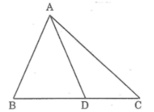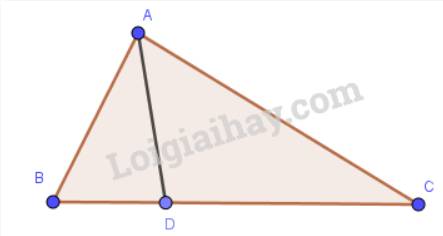Tính chu vi 1 tam giác cân có 2 cạnh = 4m và 9m
Cho tam giác ABC diểm D nằm giữa B và C. Chứng minh rằng AD nhỏ hơn nửa chu vi tam giác ABC
Cho tam giác ABC, điểm D nằm giữa B và C. Chứng minh rằng AD nhỏ hơn nửa chu vi tam giác ABC.

Trong ΔABD, ta có:
AD < AB + BD (bất đẳng thức tam giác) (1)
Trong ΔADC, ta có:
AD < AC + DC (bất đẳng thức tam giác) (2)
Cộng từng vế (1) và (2), ta có:
2AD < AB + BD + AC + DC ⇔ 2AD < AB + AC + BC
Vậy AD < (AB + AC + BC) / 2 .
Cho tam giác ABC, điểm D nằm giữa B và C. Chứng minh rằng AD nhỏ hơn nửa chu vi tam giác ABC.

Áp dụng quan hệ giữa ba cạnh của tam giác ABD, ta có: AD < AB + BD
Áp dụng quan hệ giữa ba cạnh của tam giác ACD, ta có: AD < CD + AC
\(\Rightarrow AD + AD < AB+BD+CD+AC\)
\(\Rightarrow 2AD<AB+BC+AC\) ( vì \(DB+DC=BC\))
\(\Rightarrow\) 2AD < Chu vi tam giác ABC hay AD < (Chu vi tam giác ABC) : 2
Vậy AD nhỏ hơn nửa chu vi tam giác ABC.
Cho tam giác ABC, điểm D nằm giữa B và C. Chứng minh rằng AD nhỏ hơn nửa chu vi tam giác ABC ?
XétΔABD có AD<AB+BD(1)
Xét ΔACD có AD<AC+CD(2)
Từ (1) và (2) suy ra \(2AD< AB+AC+BC\)
hay \(AD< \dfrac{AB+AC+BC}{2}=\dfrac{C_{ABC}}{2}\)
Bài 4: Cho tam giác ABC,điểm D là điểm nằm giữa B và C.
a) Chứng minh AD bé hơn nửa chu vi tam giác ABC
b) E là điểm nằm tùy ý ở bên trong tam giác ABC chứng minh tổng khoảng cách từ E đến mỗi đỉnh của tam giác luôn lớn hơn nửa chu vi và bé hơn chu vi tam giác ABC.
Cho tam giác ABC và M là điểm nằm giữa B và C. Chứng minh rằng MA nhỏ hơn nửa chu vi tam giác ABC
theo BĐT trong tam giác ta có :
AB+BM>MA ( tg AMB)
AC+MC>MA (tg AMC)
cộng lạ nhé AB+AC+MC+MB> 2MA
AB+AC+BC> 2MA
<=> 2p > 2MA ( p là nữa chu vi )
=> p >MA (đpcm)
cho tam giác ABC, điểm D nằm giữa B và C. chứng minh AD nhỏ hơn nữa chu vi tam giác ABC
Trong ΔABD, ta có:
AD < AB + BD (bất đẳng thức tam giác) (1)
Trong ΔADC, ta có:
AD < AC + DC (bất đẳng thức tam giác) (2)
Cộng từng vế (1) và (2), ta có:
2AD < AB + BD + AC + DC ⇔ 2AD < AB + AC + BC
Vậy AD < (AB + AC + BC) / 2 .
Cho tam giác ABC. Kẻ AH vuông góc BC ( H thuộc BC). Gọi D, E, F lần lượt là
các điểm nằm giữa A và H, nằm giữa B và H, nằm giữa C và H. Chứng minh rằng
chu vi tam giác DEF nhỏ hơn chu vi tam giác ABC. Với vị trí nào của các điểm D,
E, F thì chu vi tam giác DEF bằng ½ chu vi tam giác ABC.
Giúp với mik sắp phải nộp bài rồi
Cho tam giác ABC có P; Q; R tương ứng là các điểm nằm trên các cạnh BC, CA, AB sao cho chúng chia ba chu vi tam giác ABC, tức là \(AQ+AR=BR+BP=CP+CQ\). Chứng minh rằng chu vi tam giác PQR không nhỏ hơn một nửa chu vi tam giác ABC.
Title: A Guide to Making Your School Greener
Introduction: Welcome to our guide on how to make your school greener! By implementing sustainable practices, you can contribute to a cleaner environment and create a positive impact on the planet. In this guide, we will provide you with practical steps to help you and your school become more eco-friendly.
1. Reduce Paper Usage:
Encourage digital communication: Promote the use of emails, online platforms, and shared documents instead of relying on paper-based communication.
Opt for electronic assignments: Encourage teachers to accept electronic submissions for assignments, reducing the need for printed papers.
Utilize both sides of the paper: Encourage students and staff to print on both sides of the paper whenever possible.
2. Implement Recycling Programs:
Set up recycling stations: Place recycling bins strategically throughout the school to make it convenient for everyone to recycle paper, plastic, glass, and other recyclable materials.
Educate on proper recycling: Provide clear instructions on what can and cannot be recycled, ensuring that everyone understands the recycling process.
3. Conserve Energy:
Turn off lights and electronics: Remind students and staff to switch off lights, computers, and other electronic devices when not in use.
Utilize natural lighting: Make the most of natural light by opening curtains and blinds, reducing the need for artificial lighting during the day.
Upgrade to energy-efficient appliances: Encourage the school administration to invest in energy-efficient appliances and LED lighting, reducing energy consumption.
4. Promote Water Conservation:
Fix leaks and drips: Address any leaks or drips in faucets, toilets, or other water fixtures promptly to prevent wastage.
Encourage shorter showers: Raise awareness about the importance of shorter showers to conserve water and encourage students to be mindful of their water usage.
Collect rainwater: Install rain barrels to collect rainwater for watering school gardens or other non-potable uses.
5. Develop Green Spaces:
Start a school garden: Set up a garden where students can learn about sustainable gardening practices and grow their food.
Plant native trees and plants: Native plants require less water and maintenance, while also providing habitat for local wildlife.
Create green roofs: Implement green roofs or living walls to improve insulation and reduce energy consumption while enhancing the aesthetic appeal of the school.
Conclusion: By following these steps, you can make your school a greener and more sustainable place. Remember, small changes can have a significant impact when everyone in the school community works together towards a greener future. Start implementing these practices today and lead the way in creating a more environmentally conscious school environment.
Cho điểm M nằm trong tam giác ABC. Chứng minh rằng tổng MA + MB + MC lớn hơn nửa chu vi và nhỏ hơn chu vi của tam giác ABC
áp dụng đ/lý bất đẳng thức ta có: MA < MI + IA
=> MA + MB < MI + IA + MB
=> MA + MB < IB + IA (1)
tương tự ta có: IB < IC + BC
=> IB + IA < IC + BC + IA
=> IB + IA < AC + BC (2)
từ (1) và (2) => MA + MB < AC + BC (3)
tương tự ta cũng có: MA + MC < AB + BC (4)
MB + MC < AB + AC (5)
cộng theo vế (3) ; (4) ; (5) ta có:
MA + MB + MA + MC + MB + MC < AC + BC+ AB + BC + AB + AC
2( MA + MB + MC) < 2( AB + AC + BC)
MA + MB + MC < AB + AC + BC ( vì cùng chia 2 vế cho 2) (6)
áp dụng đ/lý bất đẳng thức tam giác ta có:
AB < MA + MB
AC < MA + MC
BC < MC + MB
cộng theo vế của các bất đẳng thức trên ta có:
AB + AC + BC < MA + MB + MA + MC + MC + MB
AB + AC + BC < 2( MA + MB + MC)
AB + AC + BC / 2 MA + MB + MC ( chia cả 2 vế cho 2) (7)
từ (6) và (7) => AB + AC + BC / 2< MA + MB + MC < AB + AC + BC
vậy MA + MA + MC lớn hơn nửa chu vi và nhỏ hơn chu vi tam giác ABC